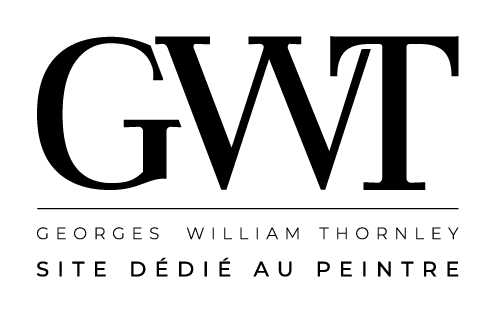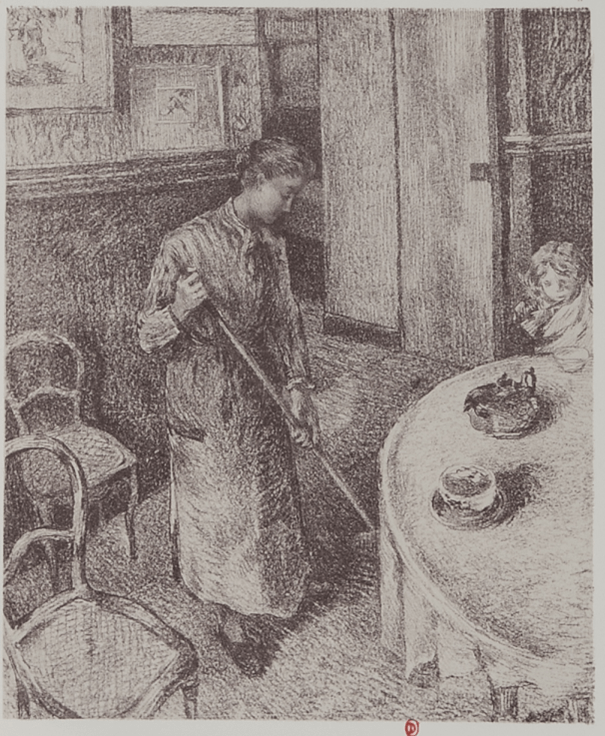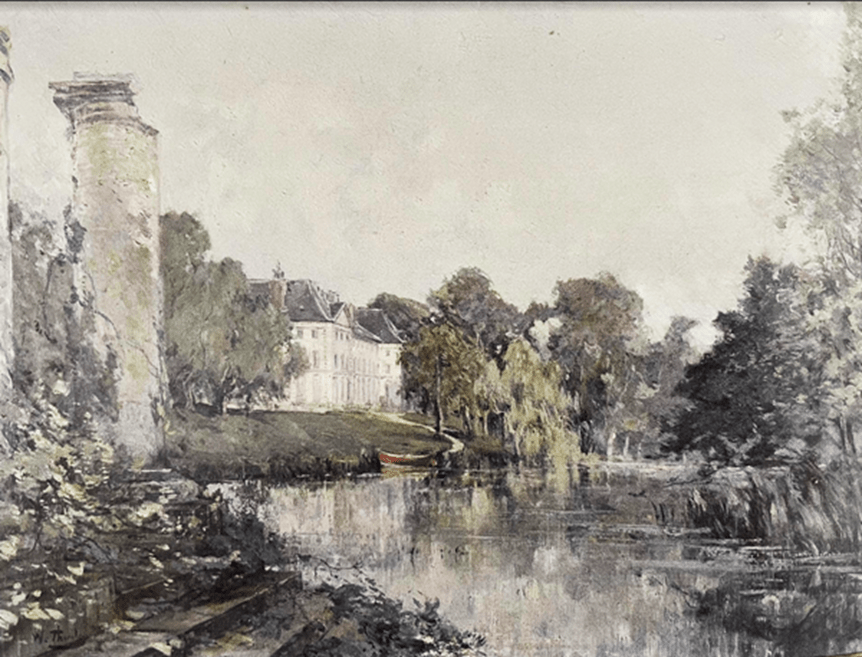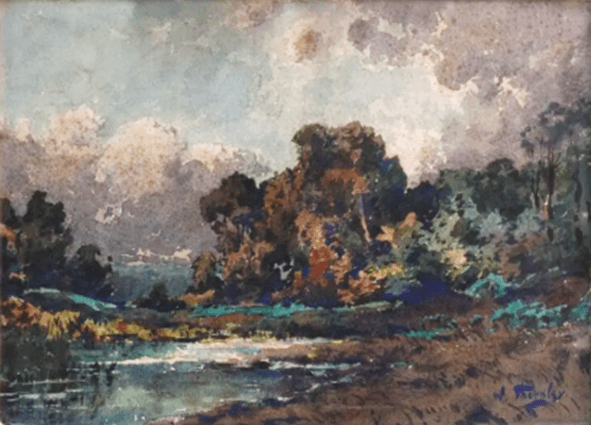Petite bonne de campagne. Lithographie de William Thornley (1857-1935) d’après Camille Pissarro (1830-1903). Origine du visuel : INHA (0618_doucet_FEST617) – Sous licence ouverte. Il s’agit de la 14ème planche de l’album édité chez Hessèle en 1900 et imprimé en 108 exemplaires par R. Engelmann (Atelier Belfond). Dimensions de la vue : 24,5 x 21,3cm.
La peinture à l’huile qui servit de modèle pour cette lithographie de William Thornley est une huile sur toile de 65x52cm qui a été réalisée par Camille Pissarro. Cette œuvre faite en 1882 fait aujourd’hui partie des collections de la National Tate Gallery à Londres. L’enfant assis à table est Ludovic Rodolphe , le quatrième fils de l’artiste.
En 1872, Paul Cézanne (1839-1906) rejoint son ami Pissarro à Pontoise. Il aura l’occasion, pendant quelques années, de le suivre à Osny pour y peindre en sa compagnie. En 1882 Camille Pissarro quitte Pontoise. Il s’installe à Osny avec sa famille et il y séjourne de décembre 1882 à début avril 1884. C’est à Osny, dans sa maison, qu’il réalise, en 1882 « la petite bonne de campagne ». Le « Peintre de Pontoise » devient alors pour plus d’une année l’un des « Peintres d’Osny ».
Il réalise de nombreux paysages, dans le village et ses alentours, parfois en compagnie de son ami Paul Gauguin(1848-1903) qui résidera chez lui trois semaines en 1883.
Onze années après Camille Pissarro, William Thornley (1857-1935), peintre paysagiste indépendant s’installe à Osny en 1895. Devenu le « Peintre d’Osny » , Il y demeure jusqu’à la fin de sa vie en 1935.
Outre Cézanne, Pissarro, Gauguin et William Thornley, d’autres artistes comme Gustave Loiseau (1865-1935) Alfredo Muller (1869-1939) et Victor Le Baube (1859-1933) ont également réalisé différents paysages d’Osny et de ses environs. (voir la brochure « sur le chemin des peintres à Osny » publiée en 2023 par l’association des Amis de Grouchy).
Osny fait bel et bien partie, comme Pontoise et Auvers-sur-Oise, des « Hauts-lieux artistiques» du Val d’Oise où ce sont concrétisées au 19ème siècle des étapes importantes liées à différents mouvements picturaux. Certains parmi eux furent à la croisée de l’impressionnisme et du néo-impressionnisme. D’autres s’inscrivirent dans différents partitions postimpressionnistes qui contribuèrent à l’émergence de l’art moderne.

little country maid. Lithograph by William Thornley (1857-1935) from a model of Camille Pissarro (1830-1903). Origin of the visual: INHA (0618_doucet_FEST617) – Under open license. This is the 14th plate of the album published by Hessèle in 1900 and printed in 108 copies by R. Engelmann (Atelier Belfond). Dimensions of the view: 24.5 x 21.3cm.
The oil painting that served as a model for this lithograph by William Thornley is an oil on canvas of 65x52cm that was made by Camille Pissarro. This work made in 1882 is now part of the collections of the National Tate Gallery in London. The child sitting at the table is Ludovic Rodolphe, the artist’s fourth son.
In 1872, Paul Cézanne (1839-1906) joined his friend Pissarro in Pontoise. He had the opportunity, for a few years, to follow him to Osny to paint with him. In 1882 Camille Pissarro left Pontoise. He settled in Osny with his family and stayed there from December 1882 to early April 1884. It was in Osny, in his house, that he painted « The Little Country Maid » in 1882. The « Painter of Pontoise » then became one of the « Painters of Osny » for over a year.
He created many landscapes in the village and its surroundings, sometimes in the company of his friend Paul Gauguin (1848-1903) who stayed with him for three weeks in 1883.
Eleven years after Camille Pissarro, William Thornley (1857-1935), an independent landscape painter, settled in Osny in 1895. Having become the « Painter of Osny », he remained there until the end of his life in 1935. In addition to Cézanne, Pissarro, Gauguin and William Thornley, other artists such as Gustave Loiseau (1865-1935), Alfredo Muller (1869-1939) and Victor Le Baube (1859-1933) also created various landscapes of Osny and its surroundings. (see the brochure « on the painters’ path in Osny » published in 2023 by the Friends of Grouchy association).
Osny is indeed part, like Pontoise and Auvers-sur-Oise, of the « Artistic High Places » of the Val d’Oise where important stages linked to different pictorial movements took place in the 19th century. Some of them were at the crossroads of Impressionism and Neo-Impressionism. Others were part of different post-Impressionist partitions that contributed to the emergence of modern art.



